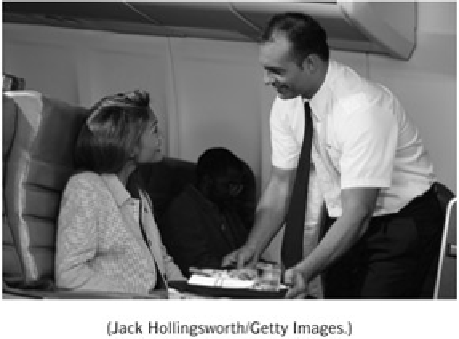Database Reference
In-Depth Information
Facilitator Roles: Flight Attendant, Sportscaster, Scientist
A smoothly run usability test can appear deceptively simple.
[
1
]
A test facilitator is like a duck—serene
on the surface, but paddling like heck underneath. There are many judgment calls that the facilitator
makes in every usability test. How long should you let the users struggle when they're stuck? When
and how should you give them hints? What do you do when there's not enough time left to complete
the task? The guidelines I provide here will help answer those questions, but it will take practice for you
to build confidence in your skills.
A test facilitator is like a duck—serene on the surface duck—serene on the surface, but paddling
like heck underneath.
In understanding what it takes to be a good facilitator, I've found it helpful to think in terms of three
roles:
1.
Flight attendant—safeguard the physical, psychological, and emotional well-being of test
participants.
2.
Sportscaster—maximize the flow of information from the users to the observers.
3.
Scientist—maintain the highest possible degree of integrity in the data.
These roles capture the essence of the facilitator's responsibilities. As you'll see later, they also provide
guidance for the inevitable situations when trade-offs arise.
The Flight Attendant
The flight attendant is the most important of the three roles. Just as a real flight attendant's primary
responsibility is the physical safety of passengers (in the early days of aviation, flight attendants were
trained nurses), the facilitator makes sure that the testing experience is emotionally nonthreatening for
participants. In the flight attendant role, the facilitator is responsible for pretest briefing and obtaining
informed consent, monitoring the users throughout the session for signs of stress, and providing
reassurance and assistance as needed. Handing out those little packets of peanuts is optional.
Comfort is important too. All usability tests should take place in an atmosphere of hospitality, which
helps relax the user. A flight attendant role is a serviceoriented one—the test facilitator should greet
users, hang up their coats, offer a beverage, and perhaps chat for a few minutes. These small
courtesies establish the facilitator in the users' minds as a helpful person who cares about their
wellbeing. I do not recommend having an assistant perform the greeter tasks and then bring the users
into the test setting where the facilitator awaits; although this may be appropriate in a scientific setting,
paper prototyping is an informal and "hightouch" activity, and it works best when the facilitator and
users have established a rapport. If circumstances require the use of a greeter, coach him or her in the
particulars of the flight attendant role.












Search WWH ::

Custom Search